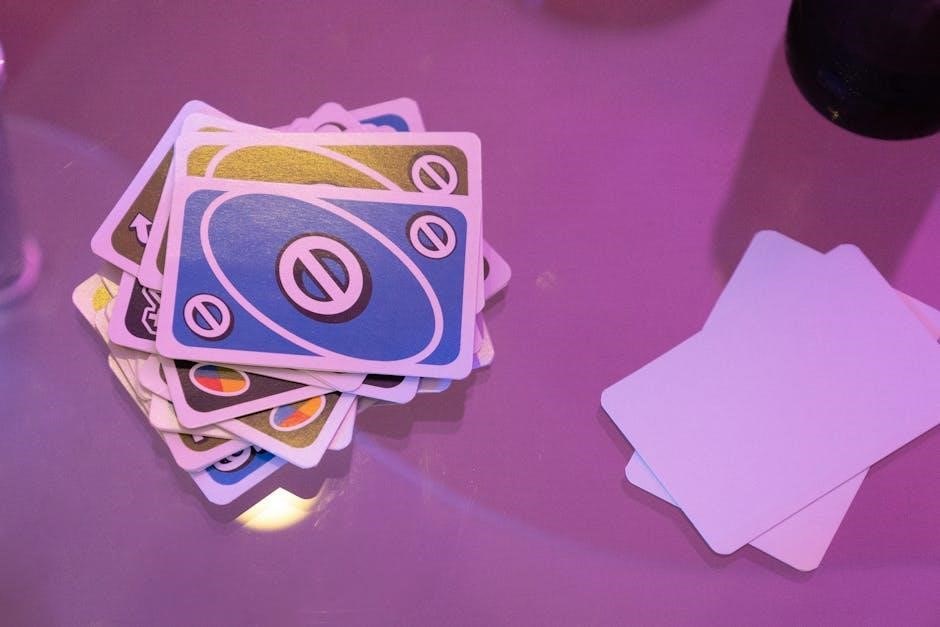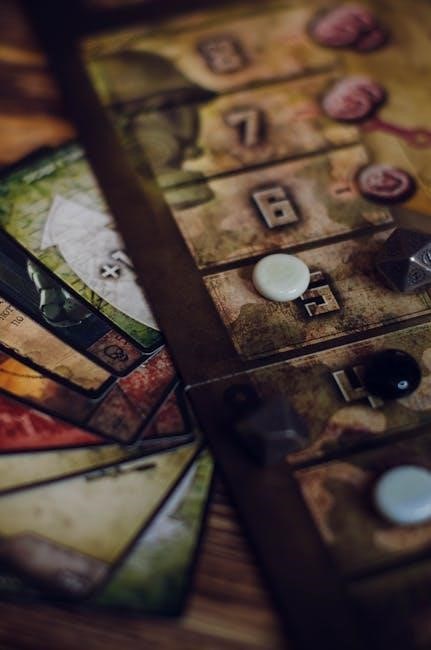The Blink Card Game is a fast-paced‚ quick-reflex game designed by Reinhard Staupe. It involves matching colors‚ numbers‚ or symbols‚ similar to Dutch Blitz‚ requiring sharp thinking and speed to win. Players race to discard cards‚ making it a thrilling experience for enthusiasts seeking rapid gameplay and strategic fun.
What is the Blink Card Game?
The Blink Card Game is a fast-paced‚ quick-reflex card game designed for two players. It involves matching colors‚ numbers‚ or symbols on cards. Players race to discard all their cards first by playing them in matching sequences. The game is known for its simplicity and speed‚ requiring sharp thinking and rapid decision-making. Special action cards add excitement and challenges. Blink is ideal for those who enjoy strategic yet quick gameplay‚ making it a favorite among card game enthusiasts. Its straightforward rules and dynamic gameplay ensure endless fun and competition.

Who Designed the Blink Card Game?
The Blink Card Game was designed by Reinhard Staupe‚ a renowned game designer known for creating fast-paced and strategic games. Staupe’s design emphasizes quick thinking and reflexes‚ making Blink a standout among card games. His innovative approach to gameplay mechanics ensures that players remain engaged and challenged. The game’s simplicity and speed are testaments to Staupe’s ability to craft engaging experiences. Blink’s popularity among card game enthusiasts can be attributed to Staupe’s clever design‚ which balances strategy with rapid gameplay. His work has made Blink a favorite for those who enjoy competitive and dynamic card games.

Why is Blink Popular Among Card Game Enthusiasts?
Blink’s popularity stems from its unique blend of speed and strategy‚ appealing to enthusiasts seeking both fun and mental challenge. Its fast-paced nature ensures that games are quick‚ making it ideal for casual and competitive play. The simplicity of matching colors‚ numbers‚ or symbols allows players of all ages to join in‚ while the need for rapid reflexes keeps the game exciting. Enthusiasts appreciate how Blink combines luck with skill‚ ensuring unpredictability and fostering healthy competition. Its portable design and ease of setup further enhance its appeal‚ making it a go-to option for gatherings and events. Overall‚ Blink’s engaging gameplay and accessibility have solidified its place as a favorite among card game enthusiasts.

Setup and Initial Preparations
Blink is designed for two players‚ using a 100-card deck with unique symbols. The deck is shuffled‚ and cards are dealt equally to both players.
Number of Players Required
Blink is specifically designed for two players‚ making it an ideal option for head-to-head competition. This setup ensures fast-paced and direct interaction between participants‚ allowing each player to focus on their strategy and reactions without distractions from additional players. The game’s structure is optimized for two participants‚ ensuring balanced gameplay and maintaining its signature speed. This limitation on players is a key element of Blink’s design‚ contributing to its quick and intense nature. The two-player format also enhances the competitive aspect‚ as each move directly impacts the opponent‚ creating a thrilling experience for card game enthusiasts. Blink’s simplicity and focus on two players make it accessible while delivering engaging gameplay.
Deck Composition and Special Cards
The Blink Card Game utilizes a unique deck of 100 cards‚ featuring colorful designs with numbers‚ symbols‚ and patterns. The deck includes 50 special cards with distinct images‚ such as animals‚ shapes‚ and objects‚ adding variety to the gameplay. These special cards are central to the game’s strategy‚ as they provide multiple matching options. Players can match based on color‚ number‚ or symbol‚ making the deck’s composition essential for quick decisions. The deck is designed to promote fast-paced action‚ with each card offering several ways to match and discard. This diverse composition ensures that no two games are alike‚ keeping players engaged and challenged. The combination of standard and special cards creates a dynamic experience tailored for rapid gameplay.

Shuffling and Dealing Cards
To begin the Blink Card Game‚ the deck is thoroughly shuffled to ensure randomness. Each player is then dealt an equal number of cards‚ typically seven‚ face down. This ensures a fair start and prepares players for rapid gameplay. The remaining cards form a draw pile‚ allowing players to replenish their hands as needed. Proper shuffling and dealing are crucial to maintain the game’s balance and excitement. The process is straightforward‚ enabling quick setup and immediate play. This efficient preparation ensures that the game starts smoothly‚ with all players ready to match cards swiftly. The emphasis is on speed‚ so the dealing must be done promptly to keep the pace of the game consistent from the start. This setup guarantees a lively and competitive experience for everyone involved.

Gameplay Rules
The Blink Card Game involves matching colors‚ numbers‚ or symbols. Players quickly discard cards into a central pile‚ with the fastest reflexes determining the winner.
Matching Rules: Colors‚ Numbers‚ and Symbols
In Blink‚ players must match either the color‚ number‚ or symbol of the top card on the discard pile. This rule applies to all cards in play‚ ensuring quick thinking and fast reflexes are essential. The ability to recognize patterns swiftly is key‚ as the game moves rapidly‚ requiring constant attention. Strategy involves optimizing card usage and timing to outpace opponents. The goal is to be the first to discard all cards‚ showcasing both speed and accuracy in matching rules.
Discard Pile Mechanics
The discard pile is central to Blink‚ where players race to eliminate their cards first. Each player has their own discard pile‚ ensuring simultaneous play. When a player matches the top card’s color‚ number‚ or symbol‚ they can discard a card. The mechanics allow for rapid gameplay‚ with multiple players acting at once. Strategy involves timing discards to maximize efficiency and outmaneuver opponents. The discard pile mechanics demand quick reflexes and sharp observation‚ making Blink a thrilling test of speed and accuracy for all participants.
Speed of Play and Turn-Based Action
Blink is renowned for its lightning-fast gameplay‚ requiring quick reflexes and sharp thinking. Unlike traditional turn-based games‚ Blink allows all players to act simultaneously‚ eliminating the need for waiting. The game’s pace is relentless‚ with players racing to match colors‚ numbers‚ or symbols to discard their cards. This simultaneous action creates a thrilling‚ competitive atmosphere‚ as everyone vies to be the first to empty their hand. The speed of play demands constant attention and rapid decision-making‚ making Blink a dynamic and engaging experience. Games are often over in minutes‚ showcasing its appeal for those who enjoy fast-paced‚ action-packed card games.

Winning the Game
The game concludes when a player has no cards left in their hand and draw pile‚ declaring them the winner in this fast-paced challenge.
End Conditions: When the Game Ends
The Blink Card Game concludes when one player completely depletes both their hand and draw pile‚ emerging victorious. This fast-paced ending often occurs unexpectedly‚ as players rapidly discard cards. The final discard triggers the end‚ with the last card played determining the winner. Quick thinking and strategic card management are crucial to reaching this point. The game’s swift nature ensures that players stay engaged until the very end‚ making Blink a thrilling experience for all involved.
Scoring and Determining the Winner
Scoring in Blink is straightforward‚ focusing on the speed of play rather than accumulating points. The winner is the first player to discard all their cards. Each round’s goal is to eliminate your cards quickly by matching colors‚ numbers‚ or symbols. The player who successfully plays all their cards first is declared the winner. This simple yet competitive system ensures that Blink remains a fast-paced and exciting game‚ emphasizing quick reflexes and strategic thinking over complex scoring mechanisms. The game’s clarity in determining the winner adds to its appeal among card game enthusiasts seeking a thrilling and straightforward experience.
Strategies for Success
Success in Blink requires quick thinking and sharp pattern recognition. Players must anticipate matches swiftly and optimize card usage to discard rapidly‚ ensuring efficient gameplay and victory.
Quick Thinking and Pattern Recognition

Quick thinking and pattern recognition are essential skills for excelling in the Blink Card Game. Players must rapidly identify matching colors‚ numbers‚ or symbols to discard cards swiftly. The game’s fast-paced nature demands sharp reflexes and mental agility to stay ahead of opponents. By recognizing patterns in the cards‚ players can anticipate potential matches and act decisively‚ ensuring they are the first to discard. This skill is crucial as the game progresses‚ with the pressure to think and act quickly intensifying. Mastery of these abilities allows players to clear their hands faster‚ ultimately leading to victory in this thrilling‚ rapid-fire card game.
Optimizing Card Usage and Timing
Optimizing card usage and timing is crucial for success in the Blink Card Game. Players must strategically manage their cards to maximize matching opportunities while minimizing delays. Timing plays a key role‚ as discarding a card too early or late can hinder progress. By carefully observing the discard pile and planning ahead‚ players can optimize their card usage to maintain a steady flow of discards. Effective timing ensures that players can quickly deplete their hand‚ gaining an advantage over opponents. This strategic approach not only enhances gameplay but also increases the chances of winning‚ making it a vital skill for mastering Blink. Proper card management and precise timing are essential for achieving victory in this fast-paced game.
Blink Card Game offers a fast-paced‚ thrilling experience‚ combining quick thinking with simple rules. Perfect for all ages‚ it ensures endless fun and mental sharpness for players.
Benefits of Playing Blink
Playing Blink offers numerous cognitive and social benefits. It enhances quick thinking‚ pattern recognition‚ and decision-making skills. The game’s fast-paced nature improves reflexes and mental agility. Additionally‚ Blink fosters healthy competition and social interaction‚ making it an excellent activity for families and friends. The simplicity of the rules allows players of all ages to participate‚ ensuring inclusivity and fun. Regular play can also boost concentration and memory‚ as players must constantly observe and react to changes in the game. Overall‚ Blink is a versatile and engaging game that combines entertainment with mental stimulation‚ making it a great addition to any game collection.

